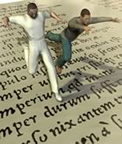
IDEAS
Identity, Transformation, and Digital Languages: a conversation with Ali Zaidi Antonio Pizzo: Motiroti is a London based international arts organisation founded by Ali Zaidi and Keith Khan in 1996. Zaidi describes himself as Indian by birth, Pakistani by migration and British by chance. Together with his art companion, he has been working with traditional art craft and new digital media in public events and performance. They have growth steadily during the years, and they were commissioned the Commonwealth Section of the Queen's Jubilee Parade in London on 2002. Now they are a well know art organization and, after Khan left, Ali Zaidi is the only artistic director. His work has always being about identity and cultural displacement, confronting a world that struggle against globalisation and homologation. The way he approaches art blurs the boundaries between films, theatre, performance, and it rather focuses on the communality of the experience. Most of the time he makes a heavy use of digital technology, bringing out what one could call digital communal performance.

The Creative Common Misunderstanding by Florian Cramer: Whatever stance one may adopt, the name "Creative Commons" is misleading because it doesn't create a commons at all. A picture released, for example, under the Attribution-ShareAlike license cannot legally be integrated into a video released under the Attribution-NonCommercial license, audio published under the Sampling License can't be used on its soundtrack. Such incompatible license terms put what is supposed to be "free content" or "free information" back to square one, that is, the default restrictions of copyright - hardly that what Lawrence Lessig, founder of the Creative Commons, could have meant with "free culture" and "read-write culture" as opposed to "read-only culture." In his blog entry "Creative Commons Is Broken," Alex Bosworth, program manager at the open source company SourceLabs, points out that "of eight million photos" posted under a CC license on Flickr.com "less than a fifth allow free remixing of content under terms similar to an open source license. More than a third don't allow any modifications at all."

Ready for Action by Jordan Crandall: We have a critical vocabulary to understand the power of media in terms of its ideological effects. Yet we lack a vocabulary to understand the power of media otherwise: that is, in terms of its ability to transmit affects. During at least the last forty years, criticism has focused on the social and cultural construction of knowledge. It has directed attention toward the conditions that make meaning possible. It has been useful for debunking beliefs, powers, illusions, essentialist truths. But for the reasons pointed out here, it only gives us half the picture: the world of form, rather than that of force. Language, rather than readiness. Speech, but not the screech. How, then, can we expand the language of cultural analysis in order to account for this affective dimension of readiness? And, further, how can we use this orientation to generate a reinvigorated, performative politics? Might we speak of an "affective critique"? Or is the term "critique" no longer useful at all?
Originally posted on networked_performance by jo



